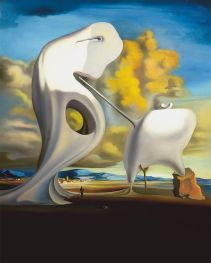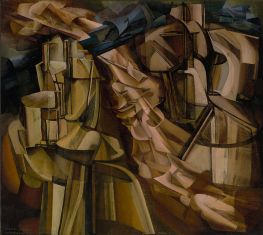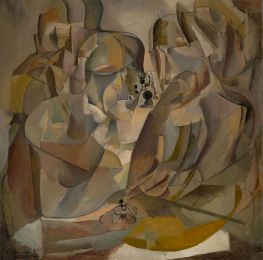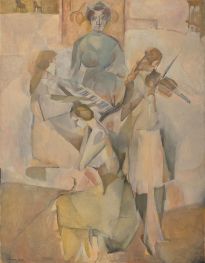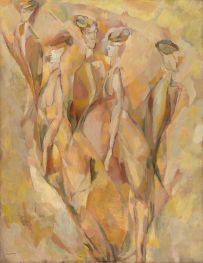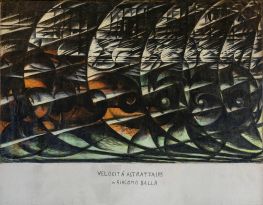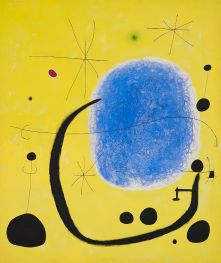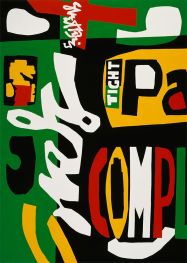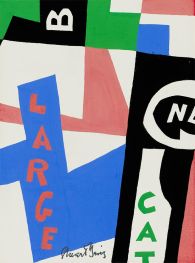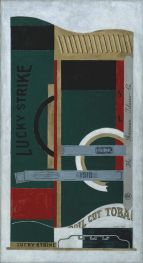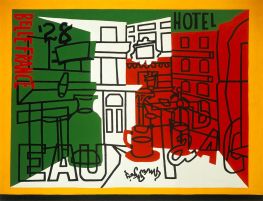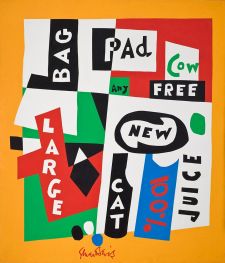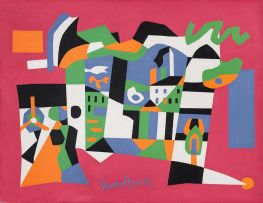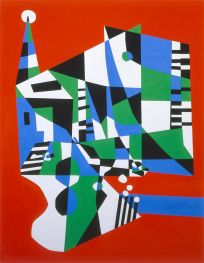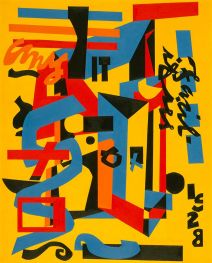Abstract Art Prints - Page 1
Abstractionism, also known as Abstract Art, is a style of art that originated in the early 20th century and is characterized by a focus on form, color, and texture rather than representation. This movement was a major departure from the traditional representational art that had dominated Western art for centuries, and it had a significant impact on the development of modern art.
Abstractionism emerged in several different countries and was influenced by a range of artistic and cultural movements. In Russia, for example, the Suprematist movement led by Kazimir Malevich was a key influence on the development of abstractionism. Malevich believed that art should be purely non-objective and that it should strive for a sense of spiritual purity and transcendence.
In Germany, the Bauhaus school was a major center for the development of abstractionism. Founded by Walter Gropius in 1919, the Bauhaus was an interdisciplinary school that brought together artists, architects, and designers. The school emphasized the importance of simplicity, functionality, and abstraction in design, and it had a significant impact on the development of modernist architecture and design.
In the United States, abstractionism emerged in the 1940s and 1950s as part of the broader movement of Abstract Expressionism. Abstract Expressionist artists such as Jackson Pollock, Mark Rothko, and Willem de Kooning sought to create works of art that expressed emotional and spiritual themes through the use of abstract forms and colors.
One of the key features of abstractionism is the use of color and form to create a sense of visual harmony and balance. Many abstractionist artists use geometric shapes and bold colors in their work, and they often explore the relationships between these elements in different ways.
Another important feature of abstractionism is its emphasis on the process of creating art. Many abstractionist artists place a strong emphasis on the act of making art, and they often allow chance and spontaneity to play a role in the creation of their works.
In addition to Abstract Expressionism, other movements that have been associated with abstractionism include Minimalism, Op Art, and Color Field painting. Each of these movements explored different aspects of abstractionism and had a significant impact on the development of modern art.
Today, abstractionism remains an important and influential style of art, and it continues to inspire artists and designers around the world.
Abstractionism emerged in several different countries and was influenced by a range of artistic and cultural movements. In Russia, for example, the Suprematist movement led by Kazimir Malevich was a key influence on the development of abstractionism. Malevich believed that art should be purely non-objective and that it should strive for a sense of spiritual purity and transcendence.
In Germany, the Bauhaus school was a major center for the development of abstractionism. Founded by Walter Gropius in 1919, the Bauhaus was an interdisciplinary school that brought together artists, architects, and designers. The school emphasized the importance of simplicity, functionality, and abstraction in design, and it had a significant impact on the development of modernist architecture and design.
In the United States, abstractionism emerged in the 1940s and 1950s as part of the broader movement of Abstract Expressionism. Abstract Expressionist artists such as Jackson Pollock, Mark Rothko, and Willem de Kooning sought to create works of art that expressed emotional and spiritual themes through the use of abstract forms and colors.
One of the key features of abstractionism is the use of color and form to create a sense of visual harmony and balance. Many abstractionist artists use geometric shapes and bold colors in their work, and they often explore the relationships between these elements in different ways.
Another important feature of abstractionism is its emphasis on the process of creating art. Many abstractionist artists place a strong emphasis on the act of making art, and they often allow chance and spontaneity to play a role in the creation of their works.
In addition to Abstract Expressionism, other movements that have been associated with abstractionism include Minimalism, Op Art, and Color Field painting. Each of these movements explored different aspects of abstractionism and had a significant impact on the development of modern art.
Today, abstractionism remains an important and influential style of art, and it continues to inspire artists and designers around the world.
Page 1 of 15
SKU: 19928-DAS
Original Size:73 x 60 cm
Museo Nacional Reina Sofia Madrid Spain
Original Size:73 x 60 cm
Museo Nacional Reina Sofia Madrid Spain
SKU: 19924-DUC
Original Size:89.5 x 55.6 cm
Philadelphia Museum of Art Pennsylvania USA
Original Size:89.5 x 55.6 cm
Philadelphia Museum of Art Pennsylvania USA
SKU: 19923-DUC
Original Size:114.6 x 129 cm
Philadelphia Museum of Art Pennsylvania USA
Original Size:114.6 x 129 cm
Philadelphia Museum of Art Pennsylvania USA
SKU: 19922-DUC
Original Size:100.6 x 100.5 cm
Philadelphia Museum of Art Pennsylvania USA
Original Size:100.6 x 100.5 cm
Philadelphia Museum of Art Pennsylvania USA
SKU: 19921-DUC
Original Size:145 x 113.3 cm
Philadelphia Museum of Art Pennsylvania USA
Original Size:145 x 113.3 cm
Philadelphia Museum of Art Pennsylvania USA
SKU: 19920-DUC
Original Size:146.4 x 114 cm
Philadelphia Museum of Art Pennsylvania USA
Original Size:146.4 x 114 cm
Philadelphia Museum of Art Pennsylvania USA
SKU: 19913-BGI
Original Size:260 x 332 cm
Pinacoteca Agnelli Torino Italy
Original Size:260 x 332 cm
Pinacoteca Agnelli Torino Italy
SKU: 19904-MIJ
Original Size:205 x 173 cm
Public Collection
Original Size:205 x 173 cm
Public Collection
SKU: 19579-STD
Original Size:52 x 41 cm
Private Collection
Original Size:52 x 41 cm
Private Collection
SKU: 19578-STD
Original Size:180.7 x 135 cm
San Francisco Museum of Modern Art California USA
Original Size:180.7 x 135 cm
San Francisco Museum of Modern Art California USA
SKU: 19577-STD
Original Size:41 x 33 cm
Art Institute of Chicago Illinois USA
Original Size:41 x 33 cm
Art Institute of Chicago Illinois USA
SKU: 19576-STD
Original Size:94 x 56 cm
Art Institute of Chicago Illinois USA
Original Size:94 x 56 cm
Art Institute of Chicago Illinois USA
SKU: 19575-STD
Original Size:30.6 x 40.5 cm
Museum of Modern Art New York USA
Original Size:30.6 x 40.5 cm
Museum of Modern Art New York USA
SKU: 19574-STD
Original Size:127.3 x 82 cm
Museum of Modern Art New York USA
Original Size:127.3 x 82 cm
Museum of Modern Art New York USA
SKU: 19573-STD
Original Size:61 x 45.6 cm
Museum of Modern Art New York USA
Original Size:61 x 45.6 cm
Museum of Modern Art New York USA
SKU: 19572-STD
Original Size:84.5 x 45.7 cm
Museum of Modern Art New York USA
Original Size:84.5 x 45.7 cm
Museum of Modern Art New York USA
SKU: 19571-STD
Original Size:71 x 91.4 cm
Private Collection
Original Size:71 x 91.4 cm
Private Collection
SKU: 19570-STD
Original Size:132 x 152.4 cm
Thyssen-Bornemisza Museum Madrid Spain
Original Size:132 x 152.4 cm
Thyssen-Bornemisza Museum Madrid Spain
SKU: 19569-STD
Original Size:147.3 x 127 cm
Los Angeles County Museum of Art California USA
Original Size:147.3 x 127 cm
Los Angeles County Museum of Art California USA
SKU: 19568-STD
Original Size:71 x 92 cm
Wadsworth Atheneum Hartford USA
Original Size:71 x 92 cm
Wadsworth Atheneum Hartford USA
SKU: 19567-STD
Original Size:91 x 71 cm
Munson Williams Proctor Art Institute Utica USA
Original Size:91 x 71 cm
Munson Williams Proctor Art Institute Utica USA
SKU: 19566-STD
Original Size:142.2 x 114.3 cm
Philadelphia Museum of Art Pennsylvania USA
Original Size:142.2 x 114.3 cm
Philadelphia Museum of Art Pennsylvania USA
SKU: 19565-STD
Original Size:132 x 101.6 cm
Metropolitan Museum of Art New York USA
Original Size:132 x 101.6 cm
Metropolitan Museum of Art New York USA
SKU: 19564-STD
Original Size:101.6 x 132 cm
Museum of Modern Art New York USA
Original Size:101.6 x 132 cm
Museum of Modern Art New York USA
